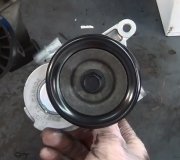There's a lot more to tires than how they look. The last thing you want to do is buy different tires from different stores or different times. That's like buying one shoe from Walmart today and a different shoe from KMart last week.
Tires have a specific rolling resistance. This isn't as important on the rear, but on the front the two have to be the same brand and model to prevent them from causing a pull or uneven handling and steering response. You will even get mismatched tires if you buy the same brand and model from the same store, but a few weeks apart.
The proper thing to do when you only want two tires is to put the new ones on the front where they will do the best job of preventing hydroplaning, and put the old ones on the back.
If the steel belts were showing, you have to also look at the rest of the tread. If the rest looks okay, there is a broken belt. You'll feel that in the seat and or the steering wheel. If the rest of the tread is worn to the end of its life, you likely have a pretty significant alignment problem. The tire salesman and the installer should be able to "read" the wear patterns. There are three things of significance and you can do two of them. The steering wheel should be centered when driving on a straight road. There can be a misalignment problem yet, but if the steering wheel is off-center, you KNOW there's a problem.
The car should go straight on a straight and level road when you let go of the steering wheel. If it pulls either way, there's normally an alignment problem, but that pull can be caused by mismatched tires too. The third thing is those wear patterns but that takes some miles to start to show up. You also need to look if both tires have the same pattern or if only one has a certain pattern.
Be aware too that some tires tend to develop broken belts, and that resulting horrendous thumping, when they're near the end of their tread life. This applies to Goodyear tires in particular. That happens even when there is no underlying alignment problem.
Wheel bearings normally start to fail by becoming noisy. They'll sound like the buzz of an airplane engine. In addition, if you have anti-lock brakes, GM has a real big problem with their front wheel bearings. The bearings don't actually have a problem. They cause a problem. They develop a little normal play, but that play causes the wheel speed sensors to develop a reduced signal. Those sensors develop a rather wimpy signal to start with, so anything that causes it to get even weaker will cause it to get so weak that the computer can't read it. That can cause false activation, typically when you're approaching a slow speed while slowing down, or it can cause the yellow warning light to turn on while driving, and that will deactivate the system. The aggravating part is a new wheel bearing can cause the same problem in as little as 15,000 miles.
If you do not have anti-lock brakes, and you need to replace the wheel bearing for some other reason, compare the prices for that bearing with and without the built-in wheel speed sensor. It's the same bearing. We found that for some applications, the bearing WITH the sensor cost less than the bearing without the sensor. Buy the less expensive one with the sensor and just don't connect it.
Sunday, April 12th, 2015 AT 12:27 AM



